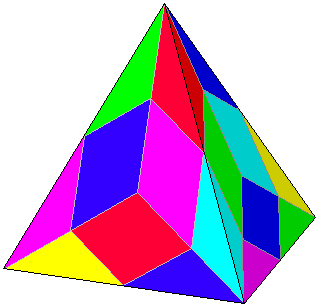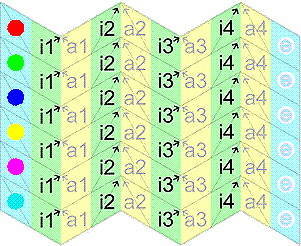| Analysis of a "Plaiting Scheme" |
zur Seite in deutscher Sprache:


 |
| Analysis of a "Plaiting Scheme" |
zur Seite in deutscher Sprache:


 |
 Consider a set of 6 congruent paper strips I, II, III, IV, V, and VI each consisting of 4 outer quadrilaterals a1, a2, a3, a4 and 4 inner quadrilaterals i1, i2, i3, i4. Inner- and outer quadrilaterals alternate, and every paper strip starts with an inner quadrilateral i1. All neighbouring quadrilaterals ix und ax are provided with an orientation as shown.
The paper strips are plaited together, using the following table:
Consider a set of 6 congruent paper strips I, II, III, IV, V, and VI each consisting of 4 outer quadrilaterals a1, a2, a3, a4 and 4 inner quadrilaterals i1, i2, i3, i4. Inner- and outer quadrilaterals alternate, and every paper strip starts with an inner quadrilateral i1. All neighbouring quadrilaterals ix und ax are provided with an orientation as shown.
The paper strips are plaited together, using the following table:| a1 | a2 | a3 | a4 | |
| I | ↑↑ i3 IV | ↑↑ i2 II | ↑↑ i1 III | ↑↑ i4 VI |
| II | ↑↑ i1 V | ↑↑ i2 III | ↑↑ i1 I | ↑↑ i2 IV |
| III | ↑↑ i1 VI | ↑↑ i2 I | ↑↑ i1 II | ↑↑ i4 V |
| IV | ↑↑ i3 VI | ↑↑ i2 V | ↑↑ i3 II | ↑↑ i4 I |
| V | ↑↑ i3 III | ↑↑ i4 II | ↑↑ i1 IV | ↑↑ i2 VI |
| VI | ↑↑ i3 I | ↑↑ i4 III | ↑↑ i3 V | ↑↑ i4 IV |
 The edges a, b, c, and d and the angles α, β, γ, δ, ε, η, κ, and λ have to be choosen within certain borders. Especially the following conditions for the angles must hold:
The edges a, b, c, and d and the angles α, β, γ, δ, ε, η, κ, and λ have to be choosen within certain borders. Especially the following conditions for the angles must hold:| 1: α(a1 I), ε(a2 IV), α(a1 V), ε(a2 III) | 2: β(a1 I), λ(a2 III), η(a2 II), δ(a3 IV) | 3: γ(a1 I), γ(a3 IV), γ(a3 II) | 4: δ(a1 I), β(a3 II); λ(a2 V), η(a2 IV) |
| 5: ε(a2 I), α(a1 II), ε(a4 V), α(a1 VI) | 6: η(a2 I), δ(a1 VI), β(a1 III); λ(a2 II) | 7: κ(a2 I), κ(a2 II), κ(a2 III) | 8: λ(a2 I), η(a2 III), δ(a1 V), β(a1 II) |
| 9: α(a3 I), ε(a4 III), α(a3 V), ε(a4 IV) | 10: β(a3 I), λ(a4 IV), η(a4 VI), δ(a1 III) | 11: γ(a3 I), γ(a1 III), γ(a1 VI) | 12: δ(a3 I), β(a1 VI); λ(a4 V), η(a4 III) |
| 13: ε(a4 I), α(a3 VI), ε(a2 V), α(a3 II) | 14: η(a4 I), δ(a3 II), β(a3 IV); λ(a4 VI) | 15: κ(a4 I), κ(a4 IV), κ(a4 VI) | 16: λ(a4 I), η(a4 IV), δ(a3 V), β(a3 VI) |
| 17: γ(a1 II), γ(a1 V), γ(a3 III) | 18: δ(a1 II), β(a3 III); λ(a2 VI), η(a2 V) | 19: ε(a2 II), α(a1 III), ε(a4 VI), α(a3 IV) | 20: ε(a4 II), α(a1 IV), ε(a2 VI), α(a3 III) |
| 21: η(a4 II), δ(a3 III), β(a1 V); λ(a2 IV) | 22: κ(a4 II), κ(a2 IV), κ(a2 V) | 23: λ(a4 II), η(a2 V), δ(a3 VI), β(a1 IV) | 24: κ(a4 III), κ(a4 V), κ(a2 VI) |
| 25: λ(a4 III), η(a2 VI), δ(a1 IV), β(a3 V) | 26: γ(a1 IV), γ(a3 VI), γ(a3 V) | ||
 | d = c = b = a α = γ = ε = κ = 120o β = δ = η = λ = 60o folding lines: the diagonals with arrows of i2, a2, i4, and a4 |  pattern download: 2593 x 2105 pix, 315 kb: tr6.gif |